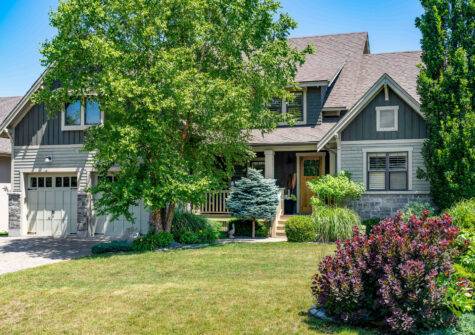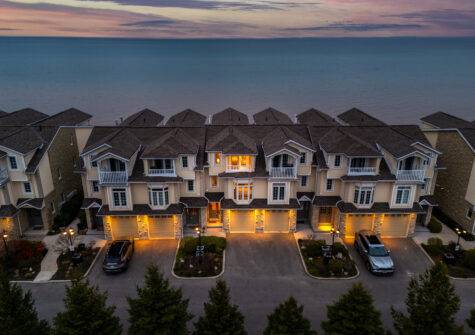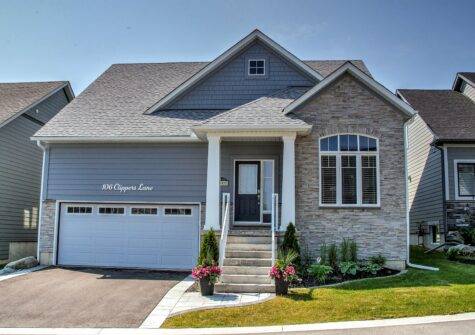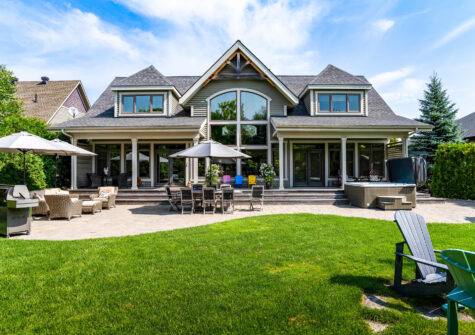Royal LePage 2022 Spring Recreational Property Report
Royal LePage forecasts double digit gain in national recreational house price in 2022, as appreciation is expected to remain strong following a sizzling 27% jump in prices in 2021
Demand continues to outstrip supply in many recreational regions, despite a return to pre-pandemic travel and interest rate increases
Highlights:
- Nationally, the aggregate price of a single-family waterfront property surged 21.5% year-over-year in 2021
- Single-family homes in Ontario’s recreational property market recorded the highest year-over-year aggregate price appreciation in 2021, rising 34.6%
- Quebec and Atlantic Canada expected to see highest recreational property price gains in 2022, rising 15%; single-family recreational homes in Ontario and British Columbia forecast to increase 13% and 12%, respectively
- 84% of recreational property experts report lower inventory than last year in their respective regions, as growing demand continues to outpace supply
 TORONTO, ON, March 31, 2022 – According to Royal LePage, the aggregate price of a single-family home in Canada’s recreational regions is forecast to increase 13.0 per cent in 2022 to $640,710, as demand continues to outpace supply.
TORONTO, ON, March 31, 2022 – According to Royal LePage, the aggregate price of a single-family home in Canada’s recreational regions is forecast to increase 13.0 per cent in 2022 to $640,710, as demand continues to outpace supply.
“The factors challenging Canada’s residential real estate market – chronic low supply and growing demand – are amplified in the recreational property segment,” said Phil Soper, president and CEO, Royal LePage. “Demand for recreational properties continues to vastly outstrip inventory in many cottage regions across the country. Waterfront and mountain-top locations near cities are limited by nature, even in a vast land like Canada, forcing buyers into multiple-offer scenarios. Even more than in urban regions, it is vital that buyers and sellers employ the services of a local agent who has recreational market expertise.”
Single-family recreational homes in Atlantic Canada and the province of Quebec are forecast to see the highest price appreciation in the country this year, set to increase 15.0 per cent, while prices in Ontario and British Columbia are forecast to increase 13.0 per cent and 12.0 per cent, respectively. According to a survey[1] of 151 Royal LePage recreational real estate professionals across the country, 84 per cent said that their market has less inventory this year than last year for their respective regions, including 50 per cent that reported significantly less available inventory.
“While the harshest of the pandemic-related restrictions may be behind us, and Canadians are starting to resume normal activities once again, some things will remain forever changed. The way we view our homes, and our connection to community and nature have shifted,” said Soper. “The desire for homes with more space, both indoors and out, is a trend that I believe will long outlive the pandemic. Many Canadians, especially those with the option to continue working remotely, are prioritizing their desired lifestyle when considering where they want to live. Recreational regions offer greater access to nature and, as a secondary property, can be a good investment if used as a rental home, even in part.”
The aggregate price of a single-family home in Canada’s recreational property regions increased 26.6 per cent year-over-year to $567,000 in 2021, compared to 2020. During the same period, the aggregate price of a single-family waterfront property increased 21.5 per cent to $976,000, and the aggregate price of a condominium rose 15.4 per cent to $374,000.
Across the country, a chronic shortage of supply of recreational properties continues to pose a challenge for buyers, often forcing them into multiple-offer situations. In Ontario, 91 per cent of Royal LePage recreational real estate professionals surveyed said that more than half of properties listed are selling above the asking price. In Atlantic Canada, 69 per cent of recreational property experts reported the same, followed by 68 and 56 per cent in Quebec and British Columbia, respectively.
“In addition to increased interest from young families, there remains a strong demand for recreational properties from buyers nearing retirement,” said Soper. “With remote work options, Canadians are transitioning into their final working years while getting to know their new community.”
The 2021 Royal LePage Boomer Survey found that 35 per cent of boomers in Canada said they were considering purchasing a primary residence within the next five years.[2] Of them, more than half (56%) said they were considering buying in a rural or recreational region, which could result in up to approximately 1.8 million Canadians having entered the recreational real estate market within the five year period.[3]
Royal LePage 2022 Spring Recreational Property Price Forecast and 2021 Price Data Chart (national and regional): rlp.ca/table_2022springrecreationalpropertyreport
Atlantic Canada
The aggregate price of a single-family home in Atlantic Canada’s recreational regions is forecast to increase 15.0 per cent in 2022 to $272,550.
In 2021, the aggregate price of a single-family home in the East Coast’s recreational market increased 24.1 per cent year-over-year to $237,000, compared to 2020. During the same period, the aggregate price of a single-family waterfront property increased 39.3 per cent to $333,000.
According to a Royal LePage survey of recreational property experts, 54 per cent of respondents in Atlantic Canada reported significantly less inventory this year, compared to last year. Sixty-nine per cent of respondents said at least half of the properties sold in their region are selling over the asking price.
“People’s inability to travel abroad for the last two years has significantly impacted recreational markets in Atlantic Canada. Strong demand for real estate from out-of-province buyers continues to create tight competition,” says Corey Huskilson, real estate professional, Royal LePage Atlantic in South Shore, Nova Scotia. “There is a lot of frustration among buyers. With very little inventory to choose from, it can be difficult to find a property that checks all the boxes on their wish list and still falls within budget.”
According to the 2021 Royal LePage Boomer Survey conducted last year, 29 per cent of boomers in Atlantic Canada said they were considering purchasing a primary residence within the next five years. Of them, 64 per cent said they were considering buying in a rural or recreational region, which could result in up to approximately 131 thousand people having entered the recreational real estate market within the five year period.[4]
Royal LePage 2022 Spring Recreational Property Price Forecast and 2021 Price Data Chart (national and regional): rlp.ca/table_2022springrecreationalpropertyreport
Quebec
The aggregate price of a single-family home in Quebec’s recreational regions is forecast to increase 15.0 per cent in 2022 to $356,500.
In 2021, the aggregate price of a single-family home in the province’s recreational market increased 24.5 per cent year-over-year to $310,000, compared to 2020. During the same period, the aggregate price of a single-family waterfront property increased 26.4 per cent to $421,000, and the aggregate price of a condominium increased 5.5 per cent to $270,000.
According to a Royal LePage survey of recreational property experts, 86 per cent of respondents in Quebec reported less inventory this year, compared to last year, including 54 per cent who reported significantly less. Sixty-eight per cent of respondents said at least half of the properties sold in their region are selling over the asking price.
Éric Léger, real estate broker with Royal LePage Humania in the Laurentians, says the significant growth of recreational property prices in the province in 2021 continued to be driven by strong demand outpacing limited supply.
“Two years after the start of the pandemic, multiple-offer scenarios continue to be common. In some cases, properties can sell between $100,000 and $125,000 over the asking price, depending on the area and the condition of the home. It’s worth noting that prior to the pandemic, homes in the region rarely sold for the list price or above. On the cusp of the spring market, demand for recreational properties remains strong in the Laurentians, and across all resort areas in the province of Quebec. As was the case last year, demand for waterfront properties is expected to continue to drive activity in the region,” said Léger.
“Buyers have adapted their lifestyles to accommodate pandemic-related restrictions, and many of these new habits will remain,” added Léger. “The need for a home office will continue to influence buyers’ choices, and as labour shortage persists, employers will need to be flexible in order to retain workers and recruit new talent. All these factors are likely to contribute to continued strong demand in the province’s recreational property markets.”
According to the 2021 Royal LePage Boomer Survey conducted last year, 29 per cent of boomers in Quebec said they were considering purchasing a primary residence within the next five years. Of them, 62 per cent said they were considering buying in a rural or recreational region, which could result in up to approximately 400 thousand people having entered the recreational real estate market within the five year period.[5]
Royal LePage 2022 Spring Recreational Property Price Forecast and 2021 Price Data Chart (national and regional): rlp.ca/table_2022springrecreationalpropertyreport
Ontario
The aggregate price of a single-family home in Ontario’s recreational regions is forecast to increase 13.0 per cent in 2022 to $737,890.
In 2021, the aggregate price of a single-family home in the province’s recreational market increased 34.6 per cent year-over-year to $653,000, compared to 2020; the strongest price appreciation in the country. During the same period, the aggregate price of a single-family waterfront property increased 31.8 per cent to $888,000, while the aggregate price of a condominium increased 20.7 per cent to $496,000.
“Prior to the pandemic, an entry-level property in Muskoka would have cost about $400,000. Today, the same property would not go for less than six- to seven-hundred thousand, and you won’t find many listings like this today. Inventory is at an all-time low,” said John O’Rourke, broker, Royal LePage Lakes of Muskoka. “Today, more than ever before, cottage buyers are using their properties year-round, making them even more valuable. The vast majority of buyers are coming from the GTA and the Golden Horseshoe region, as they can access the area in just a few hours. Over the past two years we have seen a marked increase in full-time residents which helps our local, service-oriented, economy.”
According to a Royal LePage survey of recreational property experts, 84 per cent of respondents in Ontario reported less inventory this year, compared to last year (44% reported slightly less, 40% reported significantly less). Eighty-seven per cent of respondents said at least 75 per cent of the properties sold in their region are selling over the asking price.
“Demand from remote workers has dipped compared to peak demand last year as workers are increasingly heading into the office. However, many buyer hopefuls are still being priced out of the recreational property market in Rideau Lakes,” said Pauline Aunger, broker of record, Royal LePage Advantage Real Estate. “Inventory is extremely thin, and I expect that will continue to be the case through the spring, resulting in further price increases this year. With tight competition and multiple offers on just about every listing, the successful buyers are the ones who are coming prepared.”
According to the 2021 Royal LePage Boomer Survey conducted last year, 37 per cent of boomers in Ontario said they were considering purchasing a primary residence within the next five years. Of them, 56 per cent said they were considering buying in a rural or recreational region, which could result in up to approximately 729 thousand people having entered the recreational real estate market within the five year period.[6]
Royal LePage 2022 Spring Recreational Property Price Forecast and 2021 Price Data Chart (national and regional): rlp.ca/table_2022springrecreationalpropertyreport
Prairies
The aggregate price of a single-family home in the Prairies’ recreational regions is forecast to increase 3.0 per cent in 2022 to $253,380.
In 2021, the aggregate price of a single-family home in the Prairie provinces’ recreational market increased 11.3 per cent year-over-year to $246,000, compared to 2020. During the same period, the aggregate price of a single-family waterfront property increased 6.2 per cent to $377,000.
According to a Royal LePage survey of recreational property experts, 84 per cent of respondents in the Prairies reported less inventory this year, compared to last year, including 46 per cent who reported significantly less. Fifty-four per cent of respondents said at least half of the properties sold in their region are selling over the asking price.
“Buyers are frustrated by the lack of available inventory in Saskatchewan’s most popular recreational regions,” said Lou Doderai, broker and owner, Royal LePage Icon Realty. “While there are thousands of lakes in the northern and eastern parts of the province, the region known as the ‘gateway to the North’ remains popular among residents looking for a weekend getaway. It can be accessed by car within an hour of Prince Albert and less than two hours from Saskatoon.”
Doderai noted a slight slowdown in demand recently, compared to earlier in the pandemic. He expects prices will stabilize this year, as activity in the region decreases with the re-opening of international travel and the rise in interest rates.
Royal LePage 2022 Spring Recreational Property Price Forecast and 2021 Price Data Chart (national and regional): rlp.ca/table_2022springrecreationalpropertyreport
Alberta
The aggregate price of a single-family home in Alberta’s recreational regions is forecast to increase 9.0 per cent in 2022 to $1,170,660.
In 2021, the aggregate price of a single-family home in the province’s recreational market increased 31.5 per cent year-over-year to $1,074,000, compared to 2020. As a large and highly-sought-after recreational destination, Canmore’s real estate market has a significant impact on the median price of a single-family home in Alberta, with its proximity to Banff National Park and luxury mountain properties.
“Strong demand continues to be driven by buyers from Western Canada, although we’ve seen an uptick in interest from Ontario and Quebec residents over the last two years. The region attracts mainly buyers planning for retirement,” said Brad Hawker, associate broker, Royal LePage Solutions. “With less than one month of inventory currently available and very little in the way of new development on the horizon, I expect the spring market will once again be very competitive for buyer hopefuls, which will put more upward pressure on prices.”
According to a Royal LePage survey of recreational property experts, 57 per cent of respondents in Alberta reported significantly less inventory this year, compared to last year.
“Cottages on Wabamun Lake and Lac Ste. Anne have always been popular among Edmonton residents looking for a summer weekend getaway within a short commute of the city,” said Tom Shearer, broker, Royal LePage Noralta Real Estate. “Since pandemic restrictions have limited Canadians’ ability to travel abroad, that demand has skyrocketed. Line-ups at boat launches and campgrounds are longer than ever, as Canadians are enjoying the outdoors. Strong demand for waterfront properties continues to put upward pressure on prices in the region, and I don’t expect there will be any relief this spring.”
According to the 2021 Royal LePage Boomer Survey conducted last year, 41 per cent of boomers in Alberta said they were considering purchasing a primary residence within the next five years. Of them, 55 per cent said they were considering buying in a rural or recreational region, which could result in up to approximately 207 thousand people having entered the recreational real estate market within the five year period.[7]
Royal LePage 2022 Spring Recreational Property Price Forecast and 2021 Price Data Chart (national and regional): rlp.ca/table_2022springrecreationalpropertyreport
British Columbia
The aggregate price of a single-family home in British Columbia’s recreational regions is forecast to increase 12.0 per cent in 2022 to $1,029,280.
In 2021, the aggregate price of a single-family home in the province’s recreational market increased 22.4 per cent year-over-year to $919,000, compared to 2020. During the same period, the aggregate price of a single-family waterfront property increased 15.2 per cent to $2,068,000, while the aggregate price of a condominium increased 16.8 per cent to $375,000.
“Demand continues to outstrip supply in the Okanagans, as the desire for more space and access to outdoors remains a top priority for many Canadians, especially those who choose to vacation within the country,” said Francis Braam, broker, Royal LePage Kelowna. “Low supply of housing in the region will continue to challenge buyers this spring, and I anticipate prices will continue their upward climb through 2022.”
According to a Royal LePage survey of recreational property experts, 63 per cent of respondents in British Columbia reported significantly less inventory this year, compared to last year. Fifty-six per cent of respondents said at least half of the properties sold in their region are selling over the asking price.
“Over the last two years, we’ve seen a significant increase in demand from Canadian buyers, both from within the province and across the country, as international travel restrictions limited our ability to vacation abroad,” said Frank Ingham, associate broker, Royal LePage Sussex. “Now that border restrictions are being lifted, I expect a lot of demand from south of the border will return to Whistler and Pemberton. This will put increasing upward pressure on recreational property prices this spring, as available inventory is already at historic lows. However, prices will likely stabilize in the fall, if interest rates continue to rise.”
According to the 2021 Royal LePage Boomer Survey conducted last year, 39 per cent of boomers in British Columbia said they were considering purchasing a primary residence within the next five years. Of them, 50 per cent said they were considering buying in a rural or recreational region, which could result in up to approximately 256 thousand people having entered the recreational real estate market within the five year period.[8]
Royal LePage 2022 Spring Recreational Property Price Forecast and 2021 Price Data Chart (national and regional): rlp.ca/table_2022springrecreationalpropertyreport
Royal LePage Royalty-Free Media Assets:
Royal LePage’s media room contains royalty-free assets, such as images and b-roll, that are free for media use.
- Media room: rlp.ca/mediaroom
- Royalty-free assets: rlp.ca/media-assets
About the Royal LePage Recreational Property Report
The Royal LePage Recreational Property Report compiles insights, data and forecasts from 44 markets. Median price data was compiled and analyzed by Royal LePage for the period between January 1, 2021 and December 31, 2021 and January 1, 2020 and December 31, 2020. Data was sourced through local brokerages and boards in each of the surveyed regions. Royal LePage’s aggregate home price is based on a weighted model using median prices. Data availability is based on a transactional threshold and whether regional data is available using the report’s standard housing types. Aggregate prices may change from previous reports due to a change in the number of participating regions.
About the Royal LePage Recreational Property Advisor Survey
A national online survey of 151 brokers and sales representatives serving buyers and sellers in Canada’s recreational property regions. The survey was conducted between March 1st 2022 and March 18th 2022.
About Royal LePage
Serving Canadians since 1913, Royal LePage is the country’s leading provider of services to real estate brokerages, with a network of approximately 19,000 real estate professionals in over 600 locations nationwide. Royal LePage is the only Canadian real estate company to have its own charitable foundation, the Royal LePage Shelter Foundation, dedicated to supporting women’s and children’s shelters and educational programs aimed at ending domestic violence. Royal LePage is a Bridgemarq Real Estate Services Inc. company, a TSX-listed corporation trading under the symbol TSX:BRE. For more information, please visit www.royallepage.ca.





